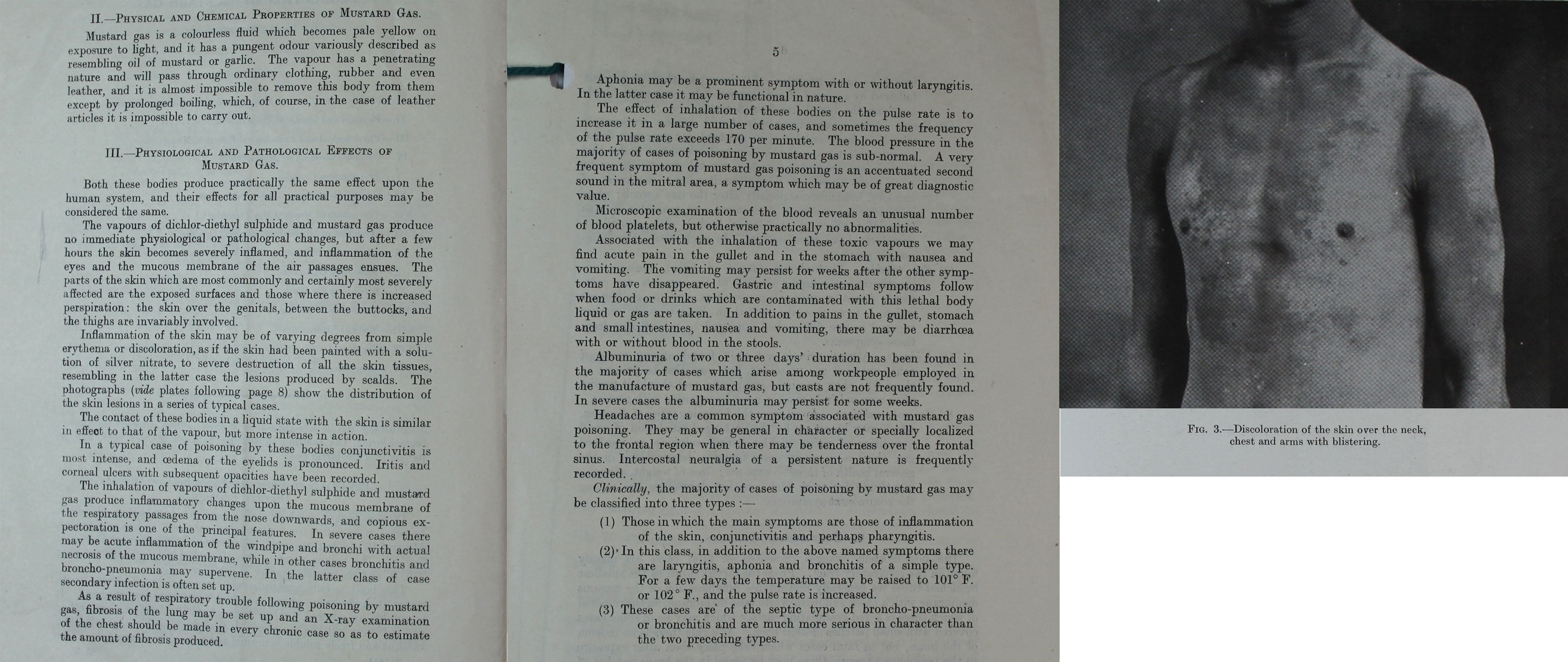
Extract and photograph entitled: ‘Discoloration of the skin over the neck, chest and arms with blistering’, both from a Report of the Chemical Warfare Medical Committee on medical aspects of mustard gas production, (Catalogue ref: WO 142/330)
Transcript
…
- – Physical and Chemical Properties of Mustard Gas
Mustard gas is a colourless fluid which becomes pale yellow on exposure to light, and it has a pungent odour variously described as resembling oil of mustard or garlic. The vapour has a penetrating nature and will pass through ordinary clothing, rubber and even leather, and it is almost impossible to remove this body from them except by prolonged boiling, which, of course, in the case of leather articles it is impossible to carry out.
III. – physiological and pathological effects of mustard gas.
Both these bodies produce practically the same effect upon the human system, and their effects for all practical purposes may be considered the same.
The vapours of dichlor-diethyl sulphide and mustard gas produce no immediate physiological or pathological changes, but after a few hours the skin becomes severely inflamed, and inflammation of the eyes and the mucous membrane of the air passages ensues. The parts of the skin which are most commonly and certainly most severely affected are the exposed surfaces and those where there is increased perspiration: the skin over the genitals, between the buttocks, and the thighs are invariably involved.
Inflammation of the skin may be of varying degrees from simple erythema or discoloration, as if the skin had been painted with a solution of silver nitrate, to severe destruction of all the skin tissues, resembling in the latter case the lesions produced by scalds. The photographs (vide plates following page 8) show the distribution of the skin lesions in a series of typical cases.
The contact of these bodies in a liquid state with the skin is similar in effect to that of the vapour, but more intense in action.
In a typical case of poisoning by these bodies conjunctivitis is most intense, and oedema of the eyelids is pronounced. Iritis and corneal ulcers with subsequent opacities have been recorded.
The inhalation of vapours of dichlor-diethyl sulphide and mustard gas produce inflammatory changes upon the mucous membrane of the respiratory passages from the nose downwards, and copious expectoration is one of the principal features. In severe cases there may be acute inflammation of the windpipe and bronchi with actual necrosis of the mucous membrane, while in other cases bronchitis and broncho-pneumonia may supervene. In the latter class of case secondary infection is often set up.
As a result of respiratory trouble following poisoning by mustard gas, fibrosis of the lung may be set up and an X-ray examination of the chest should be made in every chronic case so as to estimate the amount of fibrosis produced.
Aphonia may be a prominent symptom with or without laryngitis. In the latter case it may be functional in nature.
The effect of inhalation of these bodies on the pulse rate is to increase it in a large number of cases, and sometimes the frequency of the pulse rate exceeds 170 per minute. The blood pressure in the majority of cases of poisoning by mustard gas is sub-normal. A very frequent symptom of mustard gas poisoning in an accentuated second sound in the mitral area, a symptom which may be of great diagnostic value.
Microscopic examination of the blood reveals an unusual number of platelets, but otherwise practically no abnormalities.
Associated with the inhalation of these toxic vapours we may find acute pain in the gullet and in the stomach with nausea and vomiting. The vomiting may persist for weeks after the other symptoms have disappeared. Gastric and intestinal symptoms follow when food or drinks which are contaminated with this lethal body liquid or gas are taken. In addition to pains in the gullet, stomach and small intestines, nausea and vomiting, there may be diarrhoea with or without blood in the stools.
Albuminuria of two or three days’ duration has been found in the majority of cases which arise among workpeople employed in the manufacture of mustard gas, but casts are not frequently found. In severe cases the albuminuria may persist for some weeks.
Headaches are a common symptom associated with mustard gas poisoning. They may be general in character or specially localized to the frontal region where there may be tenderness over the frontal sinus. Intercostal neuralgia of a persistent nature is frequently recorded.
Clinically, the majority of cases of poisoning by mustard gas may be classified into three types:-
- Those in which the main symptoms are those of inflammation of the skin, conjunctivitis and perhaps pharyngitis.
- In this class, in addition to the above named symptoms there are laryngitis, aphonia and bronchitis of a simple type. For a few days the temperature may be raised to 101’F or 102 ‘F., and the pulse rate is increased.
- These cases are of the septic type of broncho-pneumonia or bronchitis and are much more serious in character than the two preceding types.
…
